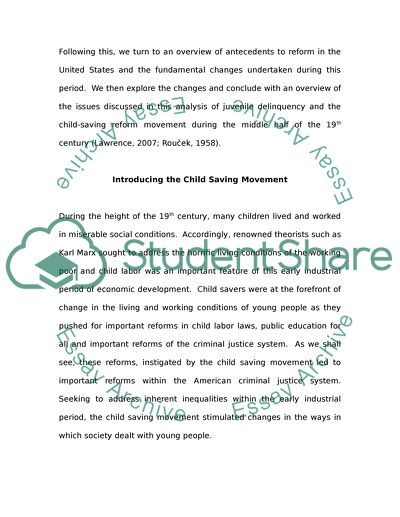Cite this document
(Evolution of Systems of Care and Control for the Delinquent Essay Example | Topics and Well Written Essays - 1750 words, n.d.)
Evolution of Systems of Care and Control for the Delinquent Essay Example | Topics and Well Written Essays - 1750 words. https://studentshare.org/law/1562500-with-reference-to-britain-or-the-united-states-in-the-period-1880s-1920s-critically-examine-the-waysin-which-the-child-saving-movement-shaped-the-evolution-of-systems-of-care-and-control-for-the-deliquent
Evolution of Systems of Care and Control for the Delinquent Essay Example | Topics and Well Written Essays - 1750 words. https://studentshare.org/law/1562500-with-reference-to-britain-or-the-united-states-in-the-period-1880s-1920s-critically-examine-the-waysin-which-the-child-saving-movement-shaped-the-evolution-of-systems-of-care-and-control-for-the-deliquent
(Evolution of Systems of Care and Control for the Delinquent Essay Example | Topics and Well Written Essays - 1750 Words)
Evolution of Systems of Care and Control for the Delinquent Essay Example | Topics and Well Written Essays - 1750 Words. https://studentshare.org/law/1562500-with-reference-to-britain-or-the-united-states-in-the-period-1880s-1920s-critically-examine-the-waysin-which-the-child-saving-movement-shaped-the-evolution-of-systems-of-care-and-control-for-the-deliquent.
Evolution of Systems of Care and Control for the Delinquent Essay Example | Topics and Well Written Essays - 1750 Words. https://studentshare.org/law/1562500-with-reference-to-britain-or-the-united-states-in-the-period-1880s-1920s-critically-examine-the-waysin-which-the-child-saving-movement-shaped-the-evolution-of-systems-of-care-and-control-for-the-deliquent.
“Evolution of Systems of Care and Control for the Delinquent Essay Example | Topics and Well Written Essays - 1750 Words”. https://studentshare.org/law/1562500-with-reference-to-britain-or-the-united-states-in-the-period-1880s-1920s-critically-examine-the-waysin-which-the-child-saving-movement-shaped-the-evolution-of-systems-of-care-and-control-for-the-deliquent.


